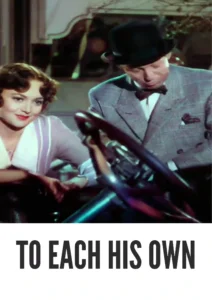Video Sources 0 Views

Download To Each His Own (1946) Colorized HD | Olivia de Havilland | Sentimental Wartime Drama
Synopsis

Immerse yourself in the heartfelt story of To Each His Own, a touching wartime drama from 1946, now beautifully colorized for a captivating viewing experience. Starring the remarkable Olivia de Havilland, this film explores themes of love, sacrifice, and enduring hope amidst the backdrop of World War I and World War II. Perfect for fans of classic romance and historical dramas, this HD download offers a timeless tale of a mother’s unwavering devotion and the complexities of human relationships. This film is also known under the title Mother is a Freshman.
To Each His Own tells the story of Jody Norris (Olivia de Havilland), a small-town woman who falls deeply in love with a pilot during World War I. When he is killed in action, Jody discovers she is pregnant. Facing societal pressures and the stigma of unwed motherhood, she makes the agonizing decision to give up her son for adoption.The film follows Jody’s life through the years, as she builds a successful business career but never forgets her son. As World War II unfolds, she encounters a young pilot, Bart Cosgrove (also played by John Lund), who bears a striking resemblance to her lost love. Jody becomes deeply involved in Bart’s life, offering him guidance and support, all while grappling with the secret of her past. The film explores the emotional complexities of Jody’s situation, as she struggles to reconcile her maternal instincts with the circumstances that have shaped her life. Ultimately, To Each His Own is a powerful and moving story about the enduring strength of a mother’s love and the sacrifices made during times of war.
The film features an exceptional cast of actors who bring this emotional story to life:
- Olivia de Havilland as Josephine “Jody” Norris
- John Lund as Bart Cosgrove / Captain Bartholomew “Bart” Norris
- Mary Anderson as Corinne Piersen
- Roland Culver as Lord Desham
- Phillip Terry as Alex Piersen
To Each His Own falls into the genre of sentimental wartime drama, blending romance, historical context, and emotional depth. Its exploration of love, loss, and sacrifice resonates with audiences, making it a timeless classic.
Released in 1946, To Each His Own reflects the post-World War II sentiments of loss, longing, and the desire for emotional connection. The film was produced during the Golden Age of Hollywood, a period known for its high production values, strong storytelling, and talented performers. To Each His Own was a critical and commercial success, earning Olivia de Havilland an Academy Award for Best Actress, solidifying her status as one of Hollywood’s leading ladies. The film’s themes of love and sacrifice resonated with audiences who had experienced the hardships of war, making it a significant cultural touchstone of its time.
This colorized version of To Each His Own has been meticulously restored using modern digital techniques, enhancing the visual appeal while preserving the film’s original emotional impact. The colorization process involved carefully analyzing the grayscale tones of the original black and white footage and assigning appropriate colors to each scene. The techniques employed included advanced algorithms for color palette selection and image enhancement. This painstaking process breathes new life into the characters and settings, making the story even more engaging for modern audiences. While debates may arise about colorizing classic films, it introduces these films to a broader audience, ensuring their legacy for future generations.
- : Mitchell Leisen
- : Charles Brackett, Jacques Thery,
- : Charles Brackett
- : Daniel L. Fapp
- : Alma Macrorie
- : Victor Young
- : Paramount Pictures
- : Paramount Pictures
- : 122 minutes
- : MP4
- : HD (1080p)
- : Compatible with most devices, including smartphones, tablets, computers, and smart TVs.
To Each His Own (1946) is celebrated for its compelling storyline, strong performances, and emotional depth. Olivia de Havilland’s portrayal of Jody Norris is widely regarded as one of the finest performances of her career, earning her an Academy Award for Best Actress. The film’s exploration of love, sacrifice, and the enduring bond between a mother and her child continues to resonate with audiences today, making it a timeless classic of the sentimental wartime drama genre.
- : What is To Each His Own about?
- A: To Each His Own is a wartime drama about a woman who gives up her son for adoption and follows her life as she grapples with the consequences of that decision.
- : Is To Each His Own (1946) a critically acclaimed film?
- A: Yes, To Each His Own was a critical and commercial success, earning Olivia de Havilland an Academy Award for Best Actress.
- : Is this version of To Each His Own colorized?
- A: Yes, this version has been professionally colorized to enhance the viewing experience.
- : What makes To Each His Own a classic film?
- A: To Each His Own is a classic film due to its compelling storyline, strong performances, and exploration of timeless themes such as love, sacrifice, and the enduring bond between a mother and her child.
- : What is the download format?
- A: The download format is MP4, which is compatible with most devices.
- : What resolution is the download?
- A: The resolution is HD (1080p), providing a high-quality viewing experience.
Watch To Each His Own Today!











